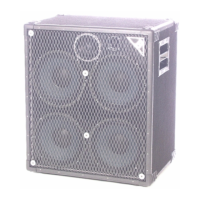Before you jump to this conclusion, listen to a wide
range program source through your speaker, such as
the output from the tweeter will be much more obvious than with some bass
guitars, particularly older, passive models.
y high crossover point makes it nearly impossible to damage this tweeter. It is very unlikely that
you will destroy it no matter
what you do. If you suspect damage, please perform the test described
above before making up your mind.
ge and tweeter are protected by an automotive light bulb which acts as a fuse. A bulb has a
distinct advantage over a simple fus
e, in that rather than simply failing, as a fuse does, a bulb will intrude
into the circuit gradually, and limit input current w
ithout failure. As input current decreases to safe levels,
the bulb will cool, and effectively remove itself from the circuit.
This is another concept pioneered by Electrovoice, to the best of my knowledge. In all honestly, the finer
of a bulb’s intrusion into the circuit, and the resultant changes in impedance and
frequency response were researched for these
Low B models to a point far beyond the work done in the
past by anyone else. The crossover was designed with the variable
tance bulb considered an integral
part of the circuit, and has been compensated for in the choice of crossover components to a d
before approached in other designs.
You will know when the bulb/fuse in your Low B system has failed: both the midr
will stop functioning. This is a rare occurrence. Even more unusual is the failure of the midrange, the
tweeter, or either attenuator. The degree of protection afforded the drivers and attenuators in the Low B
olute. The crossover circuit ensures that only the bulb/fuse will fail.
In the event of bulb failure, you can find a replacemen
t at any grocery store or service station in the
United States, or any automotive parts store in the world. The bulb is a #1156
filament automotive bulb in the world.
For the Technically Curious
nce between the Acme Low B and countless other two
ten inch clones? Why a three
way system? I’ll try to explain the concept w
ithout getting mathematical.
The most important design goal of the Acme Low B systems was to reproduce the extreme bottom end o
string bass with a compact enclosure. Consequently, superior low
end extension with low distortion
Unfortunately, the characteristics that give a woofer good bass also decrease its midrange output
(specifically, rigid cone, low resonance). Consider, for example, the venerable JBL E110. This is an
example of a 10” speaker ca
pable of exceptional clarity, efficiency, and power handling in the
midrange. A thing of beauty to be sure, and a
peaker! But as a tool for reproduction of low
bass it’s worthless. It’s built to do a different job!
The Acme woofer (a custom
Eminence) in the Low B systems is designed to be a BASS driver. It has a
heavy, stiff cone, with a long voice coil, and very co
mpliant suspension. Great for bass, but necessarily
limited at the top end. Therefore, ironically, a midrange speaker is necessa
If one were to consider the JBL E110 at one end of the “bass
scale,” and this Acme woofer at
end, then the woofers in the average two or four
ten system would be about in the middle. This
related. The difference can be expressed in numbers, and is not a matter of

